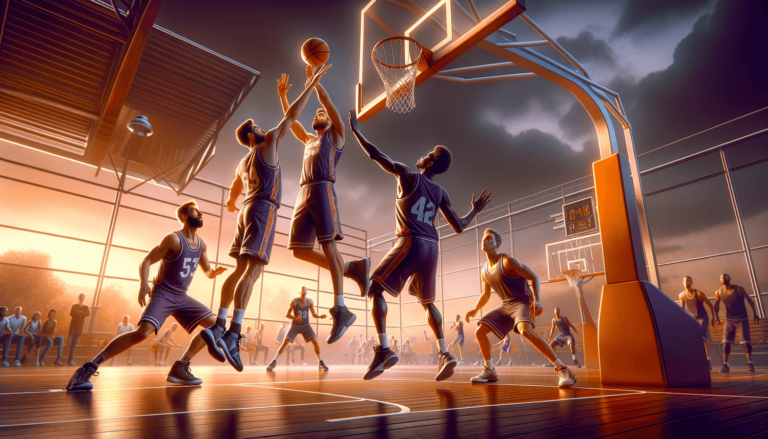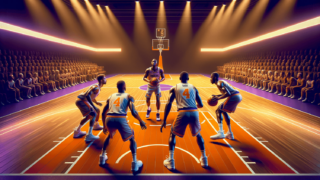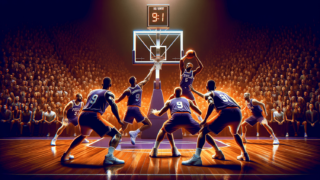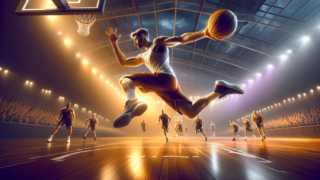
Aspiring hoopsters and established ballers alike, welcome to a blog post that will truly elevate your game in the paint! In today’s fast-paced, three-point-oriented basketball world, developing a strong post game can be a game-changing skill, offering a versatile scoring option and anchoring any offensive attack. Whether you’re a towering center or a nimble guard, an effective post game can make you a match-up nightmare for opponents. So, lace up your sneakers, channel your inner Hakeem Olajuwon or Shaquille O’Neal, and join us on this journey to discover the ins and outs of developing an unstoppable post game in basketball. Let’s get ready to rule the court, make your presence felt and add some flair to your offensive arsenal!
How to Develop a Post Game in Basketball?
To develop a post game in basketball, commit to practicing fundamental skills and tactics. Begin by understanding post positioning, establishing and maintaining a strong base, and knowing how to receive the ball effectively. Develop a repertoire of moves such as drop steps, hook shots, and up-and-unders. Don’t forget to polish your footwork, as agility and balance are crucial for executing moves. Additionally, work on your passing and decision-making skills to create opportunities for your teammates. Finally, incorporate conditioning and strength training to enhance your physicality, ensuring that you can dominate the paint.
Mastering Post Positioning
The first step to developing a post game in basketball is understanding proper post positioning. Players must know how to position themselves between the defender and the basket, ensuring they have an advantage when receiving the ball. The key is to establish a strong base and use your body to shield the defender, opening up scoring opportunities.
Finding Your Sweet Spot
Each player has a preferred spot on the court, usually close to the basket, where they feel most comfortable. Find your sweet spot, and master the art of sealing your defender, enabling you to receive the ball in an optimal position.
Cultivating a Strong Base
Regardless of your position, having a strong, stable base is essential for effective post play. Your base is the foundation for all your moves, so make sure to focus on keeping your feet shoulder-width apart, bending your knees, and maintaining a low center of gravity. This will allow you to hold your ground and absorb contact from defenders while remaining agile enough to execute your scoring moves.
Balancing Strength and Agility
Strong post players can effectively balance power and agility, enabling them to move gracefully around the court while fending off defenders. Incorporate strength training exercises into your workout routine, focusing on building lower body strength and core stability. Improve your balance and agility through footwork drills and dynamic stretching to truly maximize your post game potential.
Receiving the Ball Effectively
A successful post game begins with the ability to receive the ball effectively. As a post player, you must create separation from your defender, allowing your teammates to make clean, accurate passes. Practice the art of setting up your defender, using your body to create space and receive the ball in a position that enables you to score.
Mastering the Art of the Post Entry Pass
Work with your teammates to improve the timing and accuracy of post entry passes. Utilize various types of passes, such as bounce passes and lob passes, to ensure the ball reaches you regardless of your defender’s position. Communication is key, so make sure to use verbal and non-verbal cues to signal where and when you want the ball.
Footwork Fundamentals
Footwork is the cornerstone of every great post player’s game. Proper footwork enables you to move quickly and smoothly around the court, creating open shots and making it difficult for your defender to anticipate your moves. Dedicate time to practicing footwork drills and mastering pivoting techniques to gain an advantage in the post.
Agility and Quickness
The best post players possess incredible agility and quickness. Enhance your foot speed and agility with drills designed to improve coordination, balance, and explosive movement. Some popular footwork drills include ladder drills, box jumps, and agility cones.
Developing an Arsenal of Moves
Great post players can score in a variety of ways, from fundamental moves like drop steps and hook shots to more complex techniques like up-and-unders and fadeaways. Building a diverse arsenal of moves will help you keep defenders off-balance and create scoring opportunities in the paint.
Drop Step
The drop step is a fundamental move in the post game, allowing you to use your body to shield the defender and create an easy scoring opportunity. To execute a drop step, catch the ball in the post, pivot on your inside foot, and step towards the basket with your outside foot. Finish strong with a layup or a short-range shot.
Hook Shot
A hook shot is an effective way to score over taller defenders. Catch the ball in the post, establish a strong base, and turn your shoulders to face the basket. Extend your shooting arm away from your defender, releasing the ball with a smooth, sweeping motion. The hook shot is difficult to block and can be utilized with either hand, making it an invaluable addition to your post game repertoire.
Up-and-Under
The up-and-under is a crafty move designed to deceive defenders and create open shots. Catch the ball in the post, make an initial move as if executing a hook shot or jump shot, and then step through the defender as they attempt to block your shot. Finish with an open layup or a short-range shot, capitalizing on your defender’s overcommitment.
Decision-Making and Passing
Developing a post game is not just about scoring; it’s also about making smart decisions and creating opportunities for your teammates. As a post player, you attract attention from multiple defenders, which opens up space for your teammates to score. Recognize when to pass out of the post and create easy scoring opportunities for your fellow ballers.
Recognizing Double Teams
Learning how to identify and react to double teams is an essential part of becoming an effective post player. When faced with a double team, stay calm, survey the court, and find the open teammate. Practice passing out of double teams using various types of passes, such as skip passes and bounce passes, to make sure your teammates receive the ball in a position to score.
Developing Court Awareness
To make the best decisions in the post, you must have exceptional court awareness. This includes recognizing defensive alignments, knowing the location of your teammates, and understanding the game situation. Develop your court awareness through film study, mental repetitions during practice, and staying engaged during games, even when you are not directly involved in the play.
Strength Training and Conditioning
Incorporating strength training and conditioning is crucial to develop the physical endurance needed to excel in the post. Post players spend much of their time battling for position, which requires a combination of strength, power, and endurance. Develop a balanced workout routine that includes both strength training and conditioning exercises to improve your post game performance.
Building a Strong Core
A strong core is paramount for post players, as it provides the stability and balance needed to maintain position and withstand contact in the paint. Incorporate dynamic core exercises, such as planks, Russian twists, and medicine ball throws, to develop the power and stability required for an effective post game.
Explosive Conditioning
Explosive conditioning is essential for developing quickness and power in post players. Implement exercises like sprints, box jumps, and plyometrics to improve your explosiveness on the basketball court. By incorporating explosive conditioning in your workout routine, you will see improvements in your ability to outrun and outjump your opponents in the post.
Putting It All Together
Developing a post game in basketball requires dedication, practice, and a commitment to mastering fundamental skills. Follow the strategies and tactics outlined in this blog post, and watch as your game flourishes in the paint. Remember, true greatness comes from consistent hard work and a never-ending desire to improve. Embrace the process, and soon enough, you’ll be a force to reckon with on the basketball court.
Perfecting the Fadeaway Jump Shot
Adding a fadeaway jump shot to your post game repertoire can be a true game-changer. This difficult-to-defend shot allows you to create separation from your defender and score from almost any position in the post. While it requires practice and accuracy, perfecting the fadeaway jump shot can elevate your game and make you a serious offensive threat.
Practicing the Fadeaway Jump Shot Technique
To execute a fadeaway jump shot, begin by establishing a strong base in the post. Make a quick move to create separation from your defender, pushing off with your inside leg and leaning backward as you jump. Release the shot at the apex of your jump, using your wrist and fingers for touch and control. When performed correctly, a fadeaway jump shot is almost impossible for a defender to block.
Defending the Post
While honing your offensive post game is important, it’s equally vital to develop your defensive skills in the post. Mastering post defense not only improves your overall game, but also helps you better understand the moves and strategies used by your opponents.
Becoming a Lockdown Defender
To become a lockdown post defender, focus on maintaining a strong defensive stance, using your body to deny position and disrupt your opponent’s moves. Practice your timing to better contest and block shots, and develop your rebounding skills to limit your opponent’s second-chance scoring opportunities.
Post Game Mentality
A crucial, often overlooked aspect of developing a post game is cultivating a strong mental approach. Having confidence in your abilities and maintaining a positive mindset can help you overcome challenges, bounce back from mistakes, and ultimately excel in the post.
Learning from the Greats
Study the games of legendary post players like Hakeem Olajuwon, Kareem Abdul-Jabbar, Tim Duncan, and Shaquille O’Neal to identify key techniques and mental strategies that contributed to their success. By emulating and incorporating their skills and mindset into your game, you can further elevate your post game expertise.
Implementing Post Play in Team Offense
Integrating a strong post game into your team’s overall offensive strategy can diversify your attack and create match-up problems for your opponents. By developing a solid inside-out game, your team can exploit mismatches, create open shots for perimeter players, and unlock new scoring opportunities.
Creating Opportunities for Teammates
An effective post game not only increases your individual scoring potential, but also helps create opportunities for your teammates. By demanding attention in the paint, you force defenses to collapse, opening up valuable space for your teammates to attack and score from the perimeter.
With persistent practice and commitment to mastering the skills and strategies outlined in this guide, you can truly develop a high-level post game in basketball. Embrace the process, work on your fundamentals, and watch as your game flourishes in the paint and beyond.
Frequently Asked Questions
If you’re itching to take your post game to the next level, it’s natural to have questions. In this section, we’ll address some common queries that will help guide you on your journey to dominating the paint.
1. Can guards and smaller players benefit from developing a post game?
Absolutely! Guards and smaller players can leverage their post game to create mismatches and exploit size advantages against their defenders. A well-rounded offensive arsenal that includes post moves will make any player a more versatile threat on the court.
2. How long does it take to develop a strong post game?
Developing an effective post game takes consistent practice and dedication. The time it takes to fully develop a strong post game varies from player to player, but with persistence and focused effort, you can make significant improvements in a matter of months.
3. How do I make sure I’m practicing the right techniques and skills?
To ensure you’re practicing the correct techniques, review instructional videos, read articles, and consult with knowledgeable coaches or trainers for guidance. Observing and emulating great post players will also help you refine your skills and develop an effective post game.
4. Are there specific strength training exercises I should focus on to improve my post game?
Yes, focusing on exercises that build lower body strength, core stability, and overall power will greatly enhance your post game. Some effective strength training exercises include squats, deadlifts, lunges, planks, and step-ups.
5. Should I still practice my post game if my team primarily plays a perimeter-oriented offense?
Definitely! Even if your team relies heavily on perimeter shooting, having a strong post game can add another dimension to your team’s offensive attack. A solid post presence can create open shots for your teammates, force defenses to adapt, and provide a valuable scoring option in crucial situations.
6. How can I practice post moves on my own?
You can practice many post moves alone by simulating game situations and executing the moves against imaginary defenders. Focus on your footwork, body position, and shooting technique to refine your skills. Additionally, you can use a wall or other vertical surface to practice your post entry passes and receiving the ball in the post.
7. What are some tips for improving post defense?
Improving post defense involves working on footwork, anticipation, and positional awareness. Key tips include maintaining a strong defensive stance, using your body to deny position, contesting shots without fouling, and developing a strong rebounding technique.
8. How important is communication in the post?
Communication is critical in the post, both offensively and defensively. It helps effectively convey your intentions to your teammates, allowing them to anticipate and adjust to your movements. Verbal and non-verbal cues can make a significant difference when trying to execute post moves or maneuver around defenders on the court.
9. What are some ways to increase my explosiveness in the post?
To increase explosiveness, practice plyometric exercises like box jumps, depth jumps, and single-leg jumps. Sprint training, particularly short-distance sprints, can also enhance your speed and power in the post.
10. How can I stay motivated to work on my post game?
Setting achievable, specific goals related to your post game is a great way to stay motivated. Regularly track your progress, celebrate your small victories, and learn from your setbacks. Watching and studying successful post players can also provide a source of inspiration to keep you focused and driven.
Featured Posts
- No pillar pages found.





